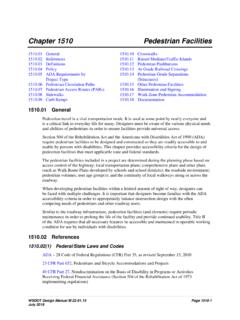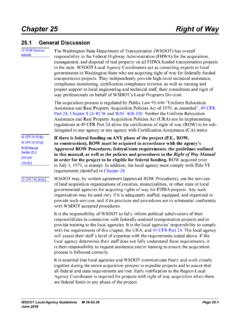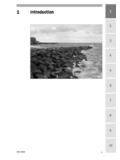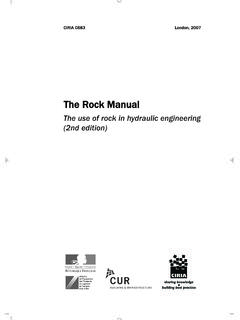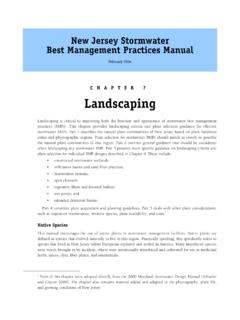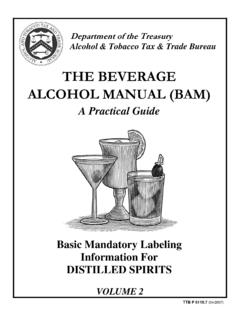Transcription of Chapter 4 Soil and Rock Classification and Logging
1 Chapter 4 Soil and Rock Classification and OverviewThe detailed description and Classification of soil and rock are an essential part of the geologic interpretation process and the geotechnical information developed to support design and construction. The description and Classification of soil and rock includes consideration of the physical characteristics and engineering properties of the material. The soil and rock descriptions that are contained on the field logs should be based on factual information. Interpretive information should not be included on the field logs, but provided elsewhere, such as in the text of geological, and geotechnical reports. This Chapter provides standards for describing and Logging soil and Unified Soil Classification System, as outlined in ASTM 2488 Standard Practices for Description of Soils (Visual Manual Procedure) , provides a conventional system for classifying soils. However, it alone does not provide adequate descriptive terminology and criteria for identifying soils for engineering purposes.
2 Therefore, the ASTM Standard has been modified to account for these additional descriptive terms and criteria. It is not intended to replace the standard but to improve upon it, and make it better are numerous rock Classification systems, but none of these is universally used. This Chapter provides a composite of those Classification systems that incorporates the significant descriptive terminology relevant to geotechnical design and important facet of soil and rock Classification is the determination of what constitutes rock , as opposed to extremely weathered, partially cemented, or altered material that approaches soil in its character and engineering characteristics. Extremely soft or decomposed rock that is friable (easily crumbled), and can be reduced to gravel size or smaller by normal hand pressure, should be classified as a Soil ClassificationSoil Classification , for engineering purposes, is based on the distribution and behavior of the fine-grained and coarse-grained soil constituents.
3 Soil descriptions that are contained on the field exploration logs are based on modified procedures as outlined in ASTM 2488. The visual - manual procedure provided in this standard utilizes visual observation and simple field index tests to identify the characteristics of the soil constituents. Definitions for the various soil constituents can be found in Table 4-1. In addition, soil properties that address angularity, consistency/relative density, color, moisture, structure, etc. have been are divided into four broad categories. These soil categories are coarse-grained soils, fine-grained inorganic soils, organic soils, and peat. The first step in identifying soil is to make a determination regarding which of the four broad categories the soil belongs. The definitions for these broad categories are as follows: Coarse Grained Soils: Soils that contain 50 % or less of soil particles passing a in. ( mm) Geotechnical Design Manual M Page 4-1 October 2013 Fine Grained Inorganic Soils: Soils that contain more than 50 % of soil particles passing a in.
4 ( mm) opening. Fine Grained Organic Soils: Soils that contain enough organic particles to influence the soil properties. Peat: Soils that are composed primarily of vegetative tissue in various stages of decomposition that has a fibrous to amorphous texture, usually dark brown to black, and an organic odor are designated as a highly organic soil called peat. Once a soil has been identified as a peat (group symbol PT), the soil should not be subjected to any further identification ConstituentDescriptionBoulderParticles of rock that will not pass through a 12 in. of rock that will pass through a 12 in. opening, but will not pass through a 3 in. of rock that will pass through a 3 in. opening, but will not pass a in. ( mm) of rock that will pass through a in. ( mm) opening, but will not pass a in. ( mm) that will pass through a in. ( mm) opening that is non-plastic or very slightly plastic and exhibits little or no strength when that will pass through a in.
5 ( mm) opening that can be made to exhibit plasticity (putty-like properties) within a range of water contents, and exhibits considerable strength when SoilSoil that contains enough organic particles to influence the soil properties. PeatSoil that is composed primarily of vegetable tissue in various stages of decomposition usually with an organic odor, a dark brown to black color, a spongy consistency, and a texture ranging from fibrous to Constituent DefinitionTable Coarse Grained SoilsCoarse grained soils are classified as either a gravel or a sand, depending on whether or not the percentage of the coarse grains are larger or smaller than a in. ( mm) opening. A soil is defined as a gravel when the estimated percentage of the gravel size particles is greater than the sand size particles. A soil is defined as a sand when the estimated percentage of the sand size particles are greater than the gravel size the soil is classified as a gravel, it is then identified as either clean or dirty.
6 Dirty means that the gravel contains an appreciable (greater than 10 %) amount of material that passes a in. ( mm) opening (fines), and clean means that the gravel is essentially free of fines (less than 10 %). The use of the terms clean and dirty are for distinction purposes only and should not be utilized in the description contained on the field and Rock Classification and Logging Chapter 4 Page 4-2 WSDOT Geotechnical Design Manual M October 2013If the gravel is clean then gradation criteria apply, and the gravel is classified as either well graded (GW) or poorly graded (GP). Well graded is defined as a soil that has a wide range of particle sizes and a substantial amount of the intermediate particle sizes. Poorly graded is defined as a soil that consists predominately of one particle size (uniformly graded), or has a wide range of particle sizes with some sizes obviously missing (gap graded). Once the grading determination has been made, the Classification can be further refined by estimating the percentage of the sand size particles present in the the gravel is dirty then it will be important to determine whether the fines are either silt or clay.
7 If the fines are determined to be silt then the gravel will be classified as a silty gravel (GM). If the fines are determined to be clay then the gravel will be classified as a clayey gravel (GC). Once the determination has been made whether the fines are silt or clay, the Classification can be further refined by estimating the percentage of sand size particles present in the sample. If the soil is classified as a sand, the same criteria that were applied to gravels are used - clean or dirty. If the sand is clean, the gradation a criterion is examined in terms of well-graded sand (SW) versus poorly graded sand (SP). Once the grading determination has been made, the Classification can be further refined by estimating the percentage of gravel size particles present in the sample. If the sand is dirty, then it will be important to determine whether the fines are silt or clay. If the fines are determined to be silt, then the sand will be classified as a silty sand (SM); conversely, if the fines are determined to be clay, then the sand will be classified as a clayey sand (SC).
8 Once the determination has been made whether the fines are silt or clay the Classification can be further refined by estimating the percentage of gravel size particles present in the sample. Table 4-2 should be used when identifying coarse grained coarse-grained soil Classification as outlined in Table 4-2 does not take into account the presence of cobbles and boulders within the soil mass. When cobbles and/ or boulders are detected, either visually within a test pit or as indicated by drilling action/core recovery, they should be reported on the field logs after the main soil description. The descriptor to be used should be as follows: with cobbles - when only cobbles are present with boulders - when only boulders are present with cobbles and boulders - when both cobbles and boulders are presentChapter 4 Soil and Rock Classification and LoggingWSDOT Geotechnical Design Manual M Page 4-3 October 2013 FinesGradingSilt or ClayGroup SymbolSand or GravelDescriptionGravel<10%Well GradedGW< 15% SandWell graded GRAVEL< 10%Well GradedGW 15% SandWell graded GRAVEL with sand< 10% Poorly GradedGP< 15% SandPoorly graded GRAVEL< 10% Poorly GradedGP 15% SandPoorly graded GRAVEL with sand> 10%SiltGM< 15% SandSilty GRAVEL> 10%SiltGM 15% SandSilty GRAVEL with sand> 10%ClayGP< 15% SandClayey GRAVEL> 10%ClayGP 15% SandClayey GRAVEL with sandSand< 10%Well GradedSW< 15% GravelWell graded SAND< 10%Well GradedSW 15% GravelWell graded SAND with gravel< 10%Poorly GradedSP< 15% GravelPoorly graded SAND< 10%Poorly GradedSP 15% GravelPoorly graded SAND with gravel>
9 10%SiltSM< 15% GravelSilty SAND> 10%SiltSM 15% GravelSilty SAND with gravel> 10%ClaySC< 15% GravelClayey SAND> 10%ClaySC 15% GravelClayey SAND with gravelField Description of Coarse Grained Soil ClassificationTable Fine-Grained Inorganic SoilsFine-grained inorganic soils are classified into four basic groups based on physical characteristics of dry strength, dilatancy, toughness, and plasticity. These physical characteristics are summarized in Table 4-3. The index tests used to determine these physical characteristics are described in ASTM 2488. Soils that appear to be similar can be grouped together. To accomplish this, one sample is completely described, and the other samples in the group are identified as similar to the completely described describing and identifying similar soil samples, it is generally not necessary to follow all of the procedures for index testing as outlined in ASTM 2488 for those GroupDry StrengthDilantancyToughnessPlasticitySil t (ML)None to LowSlow to RapidLowNon-plasticElastic Silt (MH)Low to MediumNone to SlowLow to MediumLow to MediumLean Clay (CL)Medium to HighNone to SlowMediumMediumFat Clay (CH)High to Very HighNoneHighHighField Identification of Fine Grained Inorganic SoilsTable 4-3 Soil and Rock Classification and Logging Chapter 4 Page 4-4 WSDOT Geotechnical Design Manual M October 2013 Once the major soil group has been determined, fine grained inorganic soils can be further described by estimating the percentages of fines, sand and gravel contained in the field sample.
10 Tables 4-4 through 4-7 should be used in describing fine-grained inorganic Organic Fine Grained SoilsIf the soil contains enough organic particles to influence the soil properties, it should be identified as an organic fine-grained soil. Organic soils (OL/OH) usually have a dark brown to black color and may have an organic odor. Often, organic soils will change colors, for example black to brown, when exposed to the air. Organic soils will not have a high toughness or plasticity. The thread for the toughness test will be spongy. It will be difficult to differentiate between an organic silt and an organic clay. Once it has been determined that the soil is a organic fine grained soil, the soil can be further described by estimating the percentage of fines, sand, and gravel in the field sample. Table 4-8 should be used in describing an organic fine-grained or GravelDescription> 70%< 15% Plus mmSILT> 70%15 to 25 % Plus mm% Sand > % GravelSILT with Sand> 70 %15 to 25 % Plus mm% Sand < % GravelSILT with Gravel< 70%% Sand > % Gravel< 15 % GravelSandy SILT< 70 %% Sand > % Gravel> 15% GravelSandy SILT with gravel< 70 %% Sand < % Gravel< 15 % SandGravelly SILT< 70 %% Sand < % Gravel> 15 % SandGravelly SILT with SandField Descriptions of Silt Group (ML) SoilsTable 4-4 FinesCoarsenessSand or GravelDescription> 70 %< 15 % Plus in.


